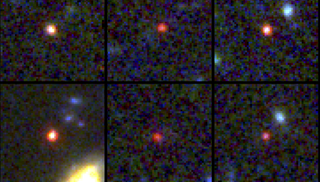James Webb Telescope spots galaxies from the dawn of time that are so massive they 'shouldn't exist'
The James Webb Space Telescope spotted six gigantic galaxies, each roughly the size of our own Milky Way, that formed at a bafflingly fast pace — taking shape just 500 million years after the Big Bang.

The James Webb Space Telescope has discovered a group of galaxies from the dawn of the universe that are so massive they shouldn't exist.
The six gargantuan galaxies, which contain almost as many stars as the Milky Way despite forming only 500 to 700 million years after the Big Bang, have been dubbed "universe breakers" by the team of astronomers that spotted them.
That's because, if they're real, the discovery calls our entire understanding of galaxy formation into question.
Related: James Webb telescope reveals the 'bones' of a distant galaxy in stunning new image
"It's bananas," co-author Erica Nelson, an assistant professor of astrophysics at the University of Colorado Boulder and one of the researchers who made the discovery, said in a statement. "You just don't expect the early universe to be able to organize itself that quickly. These galaxies should not have had time to form."
Scientists don't know exactly when the first clumps of stars began to merge into the beginnings of the galaxies we see today, but cosmologists previously estimated that the process began slowly taking shape within the first few hundred million years after the Big Bang. Currently accepted theories suggest that 1 to 2 billion years into the universe's life, these early protogalaxies reached adolescence — forming into dwarf galaxies that began devouring each other to grow into ones like our own.
Because light travels at a fixed speed through the vacuum of space, the deeper we look into the universe, the more remote light we intercept and the further back in time we see. By using the James Webb Space Telescope (JWST) to peer roughly 13.5 billion years into the past, the astronomers found that enormous galaxies had already burst into life very quickly after the Big Bang, when the universe was just 3% of its current age.
The researchers say the galaxies are so massive, they are "in tension with 99 percent of the models for cosmology." This means that either the models need to be altered, or scientific understanding of galaxy formation requires a fundamental rethink.
"The Milky Way forms about one to two new stars every year," Nelson said. "Some of these galaxies would have to be forming hundreds of new stars a year for the entire history of the universe. If even one of these galaxies is real, it will push against the limits of our understanding of cosmology."
Right now, all evidence points to these celestial objects being galaxies, but the astronomers haven't ruled out that some of them could be enormous quasars or supermassive black holes.
"This is our first glimpse back this far, so it's important that we keep an open mind about what we are seeing," co-author Joel Leja, an assistant professor of astronomy and astrophysics at The Pennsylvania State University, said in a statement. "While the data indicates they are likely galaxies, I think there is a real possibility that a few of these objects turn out to be obscured supermassive black holes. Regardless, the amount of mass we discovered means that the known mass in stars at this period of our universe is up to 100 times greater than we had previously thought. Even if we cut the sample in half, this is still an astounding change."
Previous imaging of the early universe by the Hubble Space Telescope didn't detect the giant galaxies, but JWST is about 100 times more powerful than Hubble.
The $10 billion JWST launched to a gravitationally stable location beyond the moon's orbit — known as a Lagrange point — in December 2021. The space observatory was designed to read the earliest chapters of the universe's history in its faintest glimmers of light — which have been stretched to infrared frequencies from billions of years of travel across the expanding fabric of space-time.
The astronomers say their next step will be to take a spectrum image of the giant galaxies — providing them with accurate distances and a better idea of the chemical makeup of the anachronistic monsters hiding at the beginning of the universe.
The findings were described Feb. 22 in the journal Nature.
Sign up for the Live Science daily newsletter now
Get the world’s most fascinating discoveries delivered straight to your inbox.

Ben Turner is a U.K. based staff writer at Live Science. He covers physics and astronomy, among other topics like tech and climate change. He graduated from University College London with a degree in particle physics before training as a journalist. When he's not writing, Ben enjoys reading literature, playing the guitar and embarrassing himself with chess.
-
Pearlman YeC Nice find, shared, this early proto galactic formation aligns best w/ Pearlman YeC SPIRAL cosmological redshift hypothesis and model.Reply
Pearlman YeC SPIRAL on JWTS-JADES photometry and spectroscopy https://www.academia.edu/94346772/Pearlman_YeC_SPIRAL_on_JWTS_JADES_photometry_and_spectroscopy via @academia -
Jurandyr Replyadmin said:The James Webb Space Telescope spotted six gigantic galaxies, each roughly the of our own Milky Way, that formed at a bafflingly fast pace — taking shape just 500 million years after the Big Bang.
James Webb Telescope spots galaxies from the dawn of time that are so massive they 'shouldn't exist' : Read more
Was the Big Bang a one-time event or were there, are and will always be Big Bangs?
In the possible hypothesis that Big Bangs are a prosaic occurrence in the Universe, then there would be countless space-time structures similar to ours and all expanding and that at some point may interact.
This interaction would then create an unusual situation for an observer of a Universe created in a time t2 interacting with another Universe created in a time t1 before t2.
This observer at t2 could very well observe structures of t1 that would have existed at the beginning of t2.
That is, you would see structures that shouldn't be where they are if there was only a single Universe within a larger Universe.
The possibility of the existence of multiple universes would explain structures of t1 at the beginning of t2.
Wouldn't those galaxies seen by James Webb be the confirmation of the existence of multiple universes? -
Sumpvesen Here's my 3 cents worth (3 not 2, inflation you know...)Reply
I do think that there was some sort of a big bang all those years ago. Maby because there is a maximum size a black hole can have beyond which it goes BANG causing a big bang episode . However I'm also convinced that the universe was already full of stuff scattered all over the place. Things such as black holes and galaxies were already floating around. In other words the big bang was not the beginning, it was more like a messy rebirth or recycling event. Also, trying to explain any of this with religion will only lead to mas hysteria and human sacrifices 😬😁.
I have to run, there are people outside with pitchforks...
But first, here's my question; shouldn't we be able to look far enough into the past to a point and time on the far side of where the big bang took place (in relationship to where we are) and see the actual explosion?
These thoughts give me a headache.....🤯 -
warlok Interesting. Although, it must suck to constantly have your beliefs flipped over on its head.Reply
Most Popular

By Harry Baker

By Sascha Pare